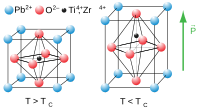
Photo from wikipedia
Abstract The PZT ceramics with different weight content from 78% to 89% were printed using the stereolithography method. The piezoelectric properties as well as the microstructure of the ceramics were… Click to show full abstract
Abstract The PZT ceramics with different weight content from 78% to 89% were printed using the stereolithography method. The piezoelectric properties as well as the microstructure of the ceramics were investigated in detail. X-ray patterns and Raman spectra demonstrate that the steady PZT tetragonal phase has already formed in these sintered ceramics. Besides, the piezoelectric constant and dielectric constant were 212–345 pC/N and 760–1390, which were sligthly lower than that of the dry pressing disk. Furthermore, a two-dimensional ultrasound transducer array (8 × 8) was designed and developed to evaluate the properties of the 3D-printed PZT ceramics.
Journal Title: Ceramics International
Year Published: 2018
Link to full text (if available)
Share on Social Media: Sign Up to like & get
recommendations!